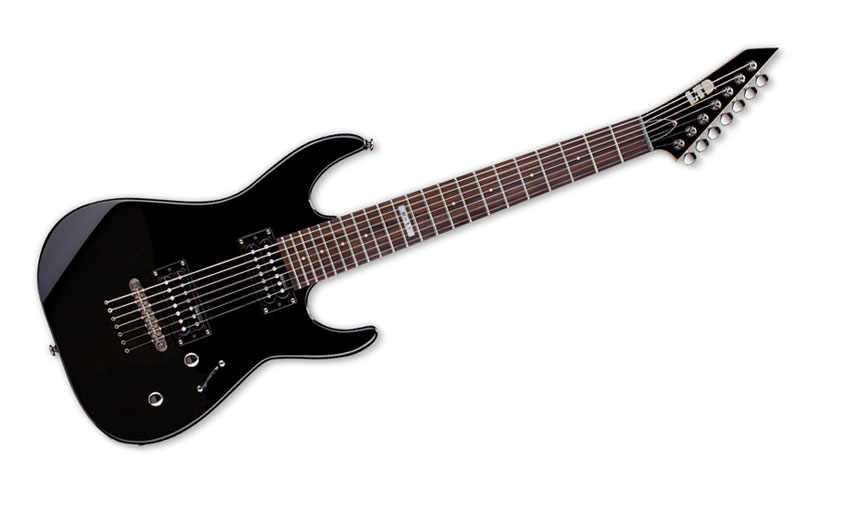MusicRadar Verdict
You might want to replace the pickups with an aftermarket set, but the fact that you can buy a seven-string of this quality for this price demonstrates the instrument's unstoppable rise from niche creation to mainstream acceptance - and if that means more guitars like this, that's fine by us.
Pros
- +
Build quality. Excellent value for money. Well featured. Extremely playable.
Cons
- -
Pickups aren't great. Poor clean tones.
MusicRadar's got your back
In this age of austerity, everyone's on the lookout for better bang for their buck, and perhaps that's why extended- range guitars have seen such a surge in popularity. A seven-string gives you more octaves for your pound, and the LTD M-17 looks to be one of the biggest bargains out there, providing all that low-end lovin' for just over £200.
Build
Sure, on paper, the spec isn't going to blow anyone away: basswood body, ESP Designed humbuckers, flat black finish... there's nothing out of the ordinary here. However, the ESP-embossed backplate and tuners, not to mention the M-17 inlay at the 12th fret, make the guitar look more expensive than it is.
"The intonation and fretwork on our model are both excellent out of the box"
The through-body stringing is a nice touch, too - it increases sustain and resonance, which proves especially satisfying when you let that low B ring. Speaking of which, the M-17 ships in standard seven-string tuning (B E A D G B E), which, coupled with its six-string-standard 648mm (25.5-inch) scale length, eases the transition for newcomers.
Considering the scale length, it's reassuring that the M-17 retains its tuning as well as it does, especially on that all-important bottom string. The intonation and fretwork on our model are both excellent out of the box, too - again, it's above and beyond what we'd expect for the outlay.
Sounds
"String definition isn't quite as sharp as the M-17's bigger brothers"
It's only when you plug in that the M-17's price tag starts to rear its not-so-attractive head. The guitar's passive ESP Designed humbuckers are lower output than the active offerings that dominate the likes of last issue's LTD SCT- 607B. That means string definition isn't quite as sharp as the M-17's bigger brothers, and you'll have to crank your amp's gain to really get your palm-muted chug on.
But what chugs they are. Don't get us wrong: these 'buckers aren't the best pups in the pack, but they can still bring the pain with gain. In fact, if you're a seven-string virgin, you might find yourself pumping out so many low-end riffs that you forget about those puny higher strings. That would be a shame, though, because the bridge humbucker isn't too shabby for solos at the dusty end, either.
The M-17 isn't going to replace your Tele for clean tones any time soon - both the neck and middle settings on the three-way pickup selector switch are a little low-end heavy for chord work without some EQ adjustment. But when the gained-up tones are this rewarding, and the neck is so eminently playable, that doesn't seem to matter.
A guitar for all seasons the M-17 is not, but it doesn't cost the earth, either.
Mike is Editor-in-Chief of GuitarWorld.com, in addition to being an offset fiend and recovering pedal addict. He has a master's degree in journalism, and has spent the past decade writing and editing for guitar publications including MusicRadar, Total Guitar and Guitarist, as well as a decade-and-a-half performing in bands of variable genre (and quality). In his free time, you'll find him making progressive instrumental rock under the nom de plume Maebe.
“If they were ever going to do the story of Nero, probably the most decadent of all the emperors, they would have to use Roy Thomas Baker”: A tribute to the legendary producer of Queen, Alice Cooper, Journey and more
“Built from the same sacred stash of NOS silicon transistors and germanium diodes, giving it the soul – and snarl – of the original”: An octave-fuzz cult classic returns as Jam Pedals resurrects the Octaurus
What’s the buzz? Meet Yellowjacket, Cherry Audio's recreation of EDP’s trend-setting Wasp from 1978











